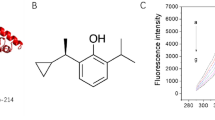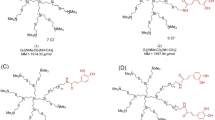Polyamidoamine (PAMAM) dendrimers' impact on human serum albumin thermal stability was investigated. Thermal denaturation profiles were determined from changes in the intrinsic fluorescence intensity. In the presence of dendrimers the shift of a denaturation temperature toward higher values was observed. It indicates a slight increase of protein stability upon dendrimers treatment.
Similar content being viewed by others
Avoid common mistakes on your manuscript.
INTRODUCTION
Dendrimers are unique polymers characterised by a hyperbranched structure and a globular shape. They are synthesised from a polyfunctional core by adding branched monomers that react with the functional groups of the core, in turn leaving end groups that can react again. The cyclic manner in which they are built results in a large number of reactive terminal groups. The more layers of branched units are added the higher so-called “generation” of dendrimers is obtained and more end groups are presented on the surface.
Dendrimers have been shown to possess unusual properties that provide many exciting opportunities in biomedical applications. Among the properties, the interactions with proteins and peptides seem especially interesting since it has been found that dendrimers have their own biological activity against scrapie prion proteins [1]. Moreover, they interact with virus proteins blocking virus attachment to the cell [2].
In the present work, the effect of polyamidoamine (PAMAM) dendrimers on human serum albumin (HSA) was examined.
PAMAM dendrimers are based on an ethylenediamine core, and branched units are constructed from both methyl acrylate and ethylenediamine [3]. It means that each layer is built in two steps. First, amino groups react with methyl acrylate monomers and then ethylenediamine is added. The sequence of reactions can be stopped after each of these two steps. That is why the half-generations of PAMAM dendrimers possess carboxylate groups on the surface and full-generations—amino groups. In the current studies, we used third and a half- (PAMAM G3.5) and fourth-generation (PAMAM G4) of polyamidoamine dendrimers. Both of them have 64 end groups on the surface. Molecular weight for PAMAM G3.5 and PAMAM G4 equals 12,419 and 14,215 Da, respectively.
Studying dendrimers' impact on a thermal denaturation process of a globular protein is the aim of this work. A spectrofluorimetric technique based on intrinsic protein emission was chosen and human serum albumin was selected as a model protein because its thermal denaturation pathway is well known. Besides this, HSA possesses only one tryptophan residue that simplifies analysis of results.
EXPERIMENTAL
Essentially fatty-acid-free HSA was purchased from Sigma (USA) and was used without further purification. PAMAM dendrimers (generation 3.5 and 4), were obtained from Aldrich (UK). All other chemicals were of analytical grade. Water used to prepare solutions was double-distilled.
HSA was dissolved in phosphate-buffered saline (PBS: 150 mmol/l NaCl, 1.9 mmol/l NaH2PO4, 8.1 mmol/l Na2HPO4, pH 7.4) at a concentration of 5 μmol/l. Fluorescence spectra were taken with a Perkin-Elmer LS-50B spectrofluorometer in a 1 cm pathlength quartz cuvette. Excitation wavelength of 295 nm was used to avoid the contribution from tyrosine residues. The excitation and emission band widths were set to 5 and 2.5 nm, respectively. The emission spectra were recorded from 305 to 470 nm. Each spectrum was the average of three scans. Measurements were taken in the temperature range of 25–90°C. Samples were continuously stirred and allowed to equilibrate to each temperature before fluorescence readings were taken. When experiments were performed in the presence of dendrimers, the concentration of dendrimers equalled to 100 μmol/l and they were added to HSA from a stock solution in PBS. It was checked that dendrimers were not excited by 295 nm wavelength and did not emit fluorescence.
RESULTS AND DISCUSSION
Previously performed studies indicate that subtle conformational changes of serum albumin appear upon addition of dendrimers. It was postulated that dendrimers create a layer on a protein surface [4]. Such a type of interactions can have two opposite consequences: stabilization or destabilization of a protein structure. When the structure is destabilized the process of thermal denaturation starts at lower temperatures. To solve the problem and answer the question we used a very sensitive method of measuring protein intrinsic fluorescence during heating. The basic information obtained by fluorescence measurements relates to the molecular environment of the chromophore, in our case a tryptophan residue.
For pure HSA, we observed that heating caused the decrease of fluorescence intensity that was accompanied by a blue-shift (Fig. 1). Quenching is a common effect occurring during denaturation. The blue-shift indicated that a tryptophan residue was in a more apolar environment. Generally, the denaturation process is associated with protein unfolding. In an unfolded form tryptophan residues are better exposed to a solvent and a red-shift is observed. Such situation takes place when a protein is denatured by guanidine hydrochloride [5]. However, it is worth remembering that each method of denaturation is considered to be a distinct process yielding different products [6]. For instance, during acid denaturation of HSA, lowering the pH from 6 to 2 resulted in a blue-shift indicating tryptophan internalization in a non-polar environment [5]. This conclusion was supported by acrylamide quenching experiments that proved that the tryptophan residue became less accessible to the solvent in the acid-denatured state than in the native one.
Any protein property that changes during the transition from a native to a denatured state may be used to obtain thermal denaturation profiles. We decided to use fluorescence intensity at 355 nm, as the decrease of emission was the most pronounced alteration (Fig. 2).
The percentage of denatured protein is given by the equation:
where F N and F D are fluorescence intensities for a native and denatured protein, respectively. F(T) is the fluorescence intensity that corresponds to temperature T. The effect of thermal quenching exists both for a protein in a native state and for a denatured protein [7]. Taking it into consideration F N and F D may be assumed to be linear functions of temperature:
Thermal denaturation profiles for pure HSA and HSA in the presence of 100 μmol/l dendrimers are shown in Fig. 3. A characteristic sigmoidal behaviour of these curves can be seen.
The thermal denaturation process can be presented as reaction N↔D with the equilibrium constant:
According to a second-order Van't Hoff equation:
For a denaturation temperature T d, [D] = [N], so ln K = 0. Therefore, T d is one of the solutions of the quadratic function:
It is graphically presented in Fig. 4.
Denaturation temperatures obtained by the spectrofluorimetric method for pure HSA, HSA in the presence of PAMAM G3.5 and PAMAM G4 dendrimer are equal to 68.3, 75.4 and 78.1°C, respectively. The value for pure HSA is similar as previously reported [8].
Both types of dendrimers stabilized the protein structure and shifted the denaturation temperature toward higher values. The impact was more pronounced for amino-terminated dendrimers. This is consistent with previous results that showed that serum albumin interacted stronger with PAMAM G4 than with PAMAM G3.5 [4]. It has been proposed that dendrimers create a layer on protein surface as a result of electrostatic interactions. At pH 7.4 albumin has the negative net charge, therefore amino-terminated cationic dendrimers have bigger impact on the protein. However, serum albumin molecule is not uniformly charged within the structure and in physiological pH domain III is weakly positively ionised, giving the place for possible contact between protein surface and anionic carboxy-terminated dendrimers. In the same paper, differential scanning calorimetry (DSC) was used to check dendrimers influence on bovine serum albumin thermal stability. Although DSC is a good and direct method for this type of studies it has limitations. It was necessary to work with a much higher concentration of albumin. Consequently dendrimers' concentrations were also higher. Both these factors could cause protein aggregation and change studied system. A sensitive spectrofluorimetric method allowed eliminating this drawback. It turned out that dendrimers stabilize protein structure by sticking to its surface. It can help to understand dendrimers role in preventing a prion protein conversion from a normal cellular structure (PrPC) into abnormally folded scrapie protein (PrPSc).
REFERENCES
S. Supattapone, H. Wille, L. Uyechi, J. Safar, P. Tremblay, F. C. Szoka, F. E. Cohen, S. B. Prusiner, and M. R. Scott (2001). Branched polyamines cure prion-infected neuroblastoma cells. J. Virol. 75, 3453–3461.
N. Bourne, L. R. Stanberry, E. R. Kern, G. Holan, B. Matthews, and D. I. Bernstein (2000). Dendrimers a new class of candidate topical microbicides with activity against herpes simplex virus infection. Antimicrob. Agents Chemother. 44, 2471–2474.
D. A. Tomalia, H. Baker, J. R. Dewald, M. Hall, G. Kallos, S. Martin, J. Roeck, J. Ryder, and P. Smith (1985). A new class of polymers: Starburst-dendritic macromolecules. Polym. J. 17, 117–132.
B. Klajnert, L. Stanislawska, M. Bryszewska, and B. Palecz (2003). Interactions between PAMAM dendrimers and bovine serum albumin. Biochim. Biophys. Acta Proteins Proteomics 1648, 115–126.
S. Muzammil, Y. Kumar, and S. Tayyab (1999). Molten globule-like state of human serum albumin at low pH. Eur. J. Biochem. 266, 26–32.
K. A. Dill and D. Shortle (1991). Denatured states of protein. Annu. Rev. Biochem. 60, 795–825.
R. K. Owusu Apenten (1995). Thermodynamic parameters for 3-state thermal denaturation of human and bovine α-lactalbumin. Thermochim. Acta 262, 1–12.
T. J. Peters (1996). All About Albumin, Biochemistry, Genetics and Medical Applications, Academic Press, San Diego.
Author information
Authors and Affiliations
Corresponding author
Rights and permissions
About this article
Cite this article
Jokiel, M., Klajnert, B. & Bryszewska, M. Use of a Spectrofluorimetric Method to Monitor Changes of Human Serum Albumin Thermal Stability in the Presence of Polyamidoamine Dendrimers. J Fluoresc 16, 149–152 (2006). https://doi.org/10.1007/s10895-005-0009-0
Received:
Accepted:
Published:
Issue Date:
DOI: https://doi.org/10.1007/s10895-005-0009-0








